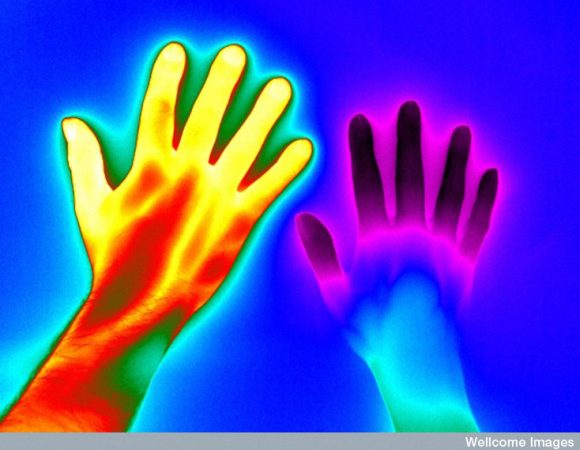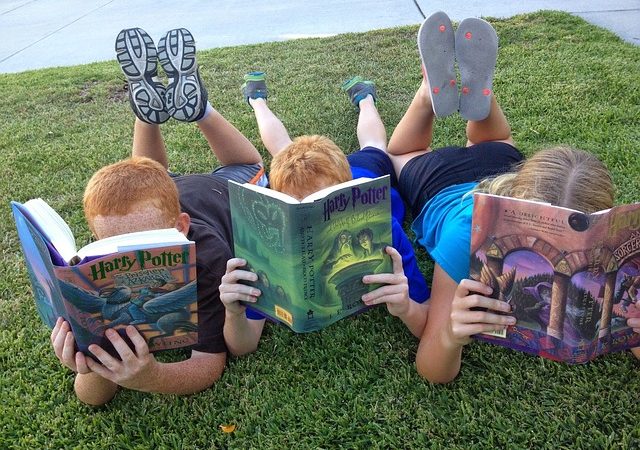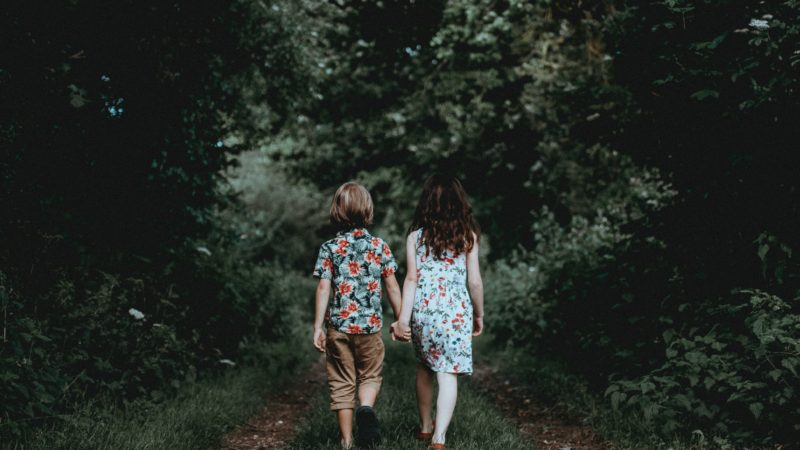
Investigating Thermoregulation – A Q&A with Dr Davide Filingeri
The Science-Aware Natural Parenting – Parenting Science Gang are currently designing an experiment to investigate how a baby’s temperature changes while in a sling. In this Q&A we quizzed Dr Davide Filingeri, an expert in environmental physiology from Loughborough University about methods for assessing body temperature and the value of our investigation. We learnt loads!
Parenting Science Gang are currently designing an experiment to investigate how a baby’s temperature changes while in a sling. In this Q&A we quizzed Dr Davide Filingeri, an expert in environmental physiology from Loughborough University about methods for assessing body temperature and the value of our investigation. We learnt loads!
Image credit: Thermal Vision Research/Wellcome Images (CC by 4.0)
Q: Davide, can you tell us a little about your research?
Davide: Sure. I have a background in environmental physiology and sensory neuroscience. My research really focuses on understanding how our bodies control our temperature and how we sense the environment through our skin (i.e. thermal sensations, touch sensations, humidity sensations).
In my lab we investigate these fundamental physiological mechanisms in healthy individuals and in patients affected by neurological disorders such as MS.
PSG I: Can you tell us about the risks of over-heating? I remember the midwife telling me to take my baby’s hat off at home but we had been told to keep it on at the birth centre. I am also aware that over-bundled babies might not wake/rouse often enough and could miss feeds, which I suppose would be a risk. Then there are the terrible stories of kids left in cars. So, what are the risks and at what age are they most acute?
Davide: Regarding overheating, this relates to the environmental conditions the baby is exposed to. It is true that if babies are over-bundled and might get hotter than what is optimal they might sleep more and lie in extended positions to reduce activity and the heat they produce.
Babies are able to sweat and can lose heat. However, if heat loss is impaired by having lots of clothes on, and heat gains are increased by the fact that the baby is in too warm a room, then it is likely that their body temperature will start to rise.
The risk of overheating is then a matter of how long the baby is then exposed to this increased heat load while being unable to lose enough heat. Those terrible stories are often stories of kids left for hours in such conditions… ?
Q: Can you tell us what you are finding out about nappies and baby body temperature?
Davide: I am afraid we have only started this project, so we are in the preliminary stage. Stay tuned in a year’s time for some news about this 🙂
Q: Davide, some people have suggested that investigating the change in temperature of a baby when their thermal environment changes is not very interesting unless it results in the baby overheating. As we don’t expect the baby to overheat, our idea is therefore not interesting.
What do you think? Are there any merits in doing this sort of experiment?
Davide: I think there is a key aspect that we have not touched on here. While it is true that if core temperature does not change, there is no actual health risk, there is a strong behavioural component related to the impact of changes in skin temperature on the baby’s mood, thermal comfort and overall wellbeing.
In this regard, your research is relevant as changes in the thermal environment will for sure impact baby’s skin temperature and that will be perceived by the baby (they can sense heat and cold very well) and will impact them in some ways, e.g. if they don’t like they’ll get restless until the temperature goes back to neutral.
Thermal comfort is very important for our overall wellbeing. I believe that investigating thermal comfort and what modifies it in babies, has merit
PSG G: So our experiment may not be investigating a life and death situation, but it’s worth doing if we care about our babies’ general happiness! I like that.
Davide: Correct, although I would not entirely dismiss the over-heating AND over-cooling aspects of using the sling. As far as I am aware there is little experimental data out there. The data produced could be very valuable to actually provide evidence for or against certain guidelines.
Q: Can you tell us a bit about how to measure babies’ temperature? A paediatrician we talked to said that rectal temperature was the most accurate way of measuring. But it may be a bit invasive and not acceptable to parents if we wanted to take babies’ temperature rectally lots of times. Is there any other way of taking babies’ temperatures which is accurate enough for what we are wanting to look at?
Davide: Hi! Regarding measuring body temperature there are different ways of doing this. The first thing to consider is whether we want to measure core (internal) temperature or skin temperature (or both).
Skin and core temperatures are usually the main parameters used to really get a sense of the body heat content and what the body is up to in terms of thermoregulation (i.e. whether it is heating up or cooling down).
Core temperature is an important indicator of internal (brain) temperature. As we can’t access the brain in vivo, usually we estimate this via measuring rectal temperature, oesophageal temperature, and tympanic temperature.
Tympanic temperature – ear temperature
“Tympanic thermometers work by reading the temperature of the tympanic membrane in the ear“ Gallimore, D., 2004. Reviewing the effectiveness of tympanic thermometers. Nursing times, 100(32), pp.32-34.
Out of the 3 above, oesophageal is the most accurate to determine changes in temperature, rectal is good to estimate body heat content, and of course tympanic is by far the least invasive.
Tympanic measures can be very reliable, however they need to be performed in a way so that the tympanic membrane is well insulated from the outside world. In the lab we do this by inserting a sensor in the ear, covering the ear canal with cotton pad so that the area is fully insulated, and then we place “industrial” head phones on the ear.
PSG F: I don’t know that we know which we want to measure! We started off interested in whether babies might overheat in a sling. So I would have thought core temperature is what we were after. But we’ve been told babies are pretty good at thermoregulation, so it’s unlikely they would overheat.
Davide: I think there are a number of things to consider about overheating. Adults are better than babies at thermoregulating but we still die of heat stroke. The point I am making is that we need to consider what external conditions the body of the baby is exposed to and those can affect both core and skin temperatures.
Example: If the baby is in the sling, moving a lot, and the parent is producing quite a lot of heat because is walking fast, the heat load that the baby might experience could be quite different depending on whether it is a hot and sunny day or a cold one.
PSG G: Davide, am I right in thinking that in an ideal situation, we don’t want our babies’ core temperatures to change much when they move between different thermal environments – that needs to stay relatively constant for the body to work well?
Davide: Yes, you are right. In general, the body tries to protect core temperature from changing much, as maintaining it within a 36.5 to 37°C range is optimal for our body to function correctly.
PSG H: Is there anyway of estimating how much excess heat a baby is generating? Given that an adult will divert blood flow to the extremities when hot, is this true of a baby, and could comparing torso temp to hand temp give a suggestion of how much a baby is trying to lose heat or do babies not thermoregulate this way?
Davide: Sure, that could be a nice way to estimate whether vasodilation (which is your baby’s first line of defence from getting hot) is taking place. In fact we use the finger to forearm difference in skin temperature in the lab as an index of vasodilation/vasoconstriction.
Vasodilation: widening of blood vessels.
“When we are too hot, blood vessels supplying blood to the skin can swell or dilate (vasodilation). This allows more warm blood to flow near the surface of the skin, where the heat can be lost to the air.” BBC Bitesize
I would indeed suggest measuring skin temperature at multiple sites (limbs, torso, head), and maybe tympanic temperature (even with the typical ear thermometer your GP uses), to estimate body heat content and potential changes to it due to the being in the sling etc.
PSG H: Could the accuracy of tympanic temperature be an issue due to one ear usually being pressed against the person carrying.
Davide: Sure, that could definitely be an issue. Take it bilaterally and note which side was against the body.
PSG H: Could it be worth comparing chest temperature to back temperature to compare how proximity to the heat source impacts skin temperature?
Davide: Absolutely – the more points on the body you measure, the better your estimation of the actual thermal state.
PSG G: Any thoughts on how fast vasodilation works in infants? (Is that the right way to use that word?!) What I’m asking is how over what period of time might we want to measure skin temperature?
Davide: Generally you see vasodilation occurring within minutes. Of course, it does depend on the heat load, i.e. how fats the body temperature is changing.
Q: Davide, I’ve seen some discussion around a breastfeeding mother’s body being able to regulate a baby’s temperature when skin to skin.
My questions are – is there any truth to this? If so, does it matter which parent is babywearing when conducting this sort of experiment (i.e. are we likely to get less accurate results with a breastfeeding mother)? And do you think the number of layers between baby and parent will make a big difference?
Davide: I admit I don’t know much about skin to skin actually regulating baby’s temperature. I would think that baby’s skin temperature is likely to adjust to mum’s skin, as the two are in direct contact.
PSG D: So for a fair experiment we would need to ensure skin to skin did not occur (i.e. have clothing/fabric between baby and wearer)?
Davide: I think it depends what question you are trying to answer. If you want to figure out what happens under a real-life scenario, then make your conditions as closer as possible to that scenario. You can always work backwards and change aspect of that scenario to then investigate the independent effect of each parameter (e.g. clothing etc).
PSG D: That makes sense, thank you.
Davide: Of course, in the context of an experiment, any layer of clothing between baby and parent will affect heat transfer in two ways:
• one, will limit heat dissipation for the parent, hence making them hotter;
• two, might limit heat gain for the baby, though the increase in parent temperature might actually end up in more heat being generated and potentially transferred to the baby anyway. Bit of a vicious cycle…..
PSG D: So how many/what layers parent and baby are wearing is quite important in terms of fair testing between various subjects.
Davide: For reducing variability in the results I’d suggest everyone to wear very similar if not identical clothing/layers.
PSG D: Perfect, thank you. Does it matter if the baby is being worn by a man or woman? Is there a difference in heat regulation between the sexes?
Davide: There is. Heat production is driven by heat produced per units of body mass – bigger person produces more heat given the same activity.
Q: Do you think whether the child is awake or asleep will have any bearing on their temperature?
PSG J: I’m thinking that an awake infant may move more causing more blood flow.
Davide: Regarding measuring temperature when awake/asleep, this is likely to have an impact. When we sleep our metabolic rate (i.e. the amount of energy we produce) drops, as minimal activity occurs. Hence it is likely that if the child is asleep they might have a slightly lower body temperature than if the child is awake and moving a lot (hence producing more heat).
PSG K: I was wondering how conditions with poor thermoregulation as a symptom can be controlled for? Me and my son are hEDS, which I’m told causes poor thermoregulation, so how does one know whether or not he is feverish when his baseline temperature is unstable?
Davide: Hi! I am sorry I am not familiar with hEDS, what does it stand for?
PSG K: Hypermobile Ehlers-Danlos Syndrome ? I was wondering less about the specific condition than about the effects in general – how do you manage to track the effects in people who have issues with thermoregulation generally ??
Davide: Thanks for clarifying! Generally speaking, more than focusing on absolute temperature per se, we tend to look at relative changes. So if you establish that your usual baseline temperature is e.g. 37.5° C, then that would be your reference point to compare whatever temperature seems above “your” normal.
Q: Would you expect front-wearing and back-wearing to make a difference to baby body temperature? Equally would you expect baby facing inwards to outwards to make a difference?
PSG C: I also wonder if adults are more intuitively able to sense a change in temperature on their chest or back?
Davide: It might make a difference, particularly in terms of body heat loss. If you are walking forward, your baby will be exposed to more air flow than if they are at the back, sheltered from air movement.
Convection (heat transfer via air movement) is a main avenue of heat transfer, so it is something to consider when looking at the effects of positioning of the baby.
In terms of sensitivity to temperature, the lower abdomen and lateral back are very sensitive areas to changes in temperature.
Q: Since thermoregulation is mostly behavioural would you say that overheating occurs more in colder climates with children who can’t communicate that they are hot? I live in Florida and it’s always so brutally hot and humid here that few of us even bother to go outside when it is bad but when we do I don’t really hear about overheating much.
Davide: That’s an interesting question. You are right, we rely heavily on behaviour for thermoregulation. The issue is that the baby’s behaviour is very influenced by the parent’s behaviour and the conditions they expose babies to.
PSG E: Yes. I wonder if parents are more likely to over dress than they are to over expose, if that makes sense?
I’m sure mistakes are more common among caregivers who are in an unusual environment. Like Floridians on vacation up north for example.
Q: My 2.5 year old’s temperature is always below 36°C using our ThermoScan, unless she’s obviously sick and complaining of being too hot and then it usually shows within the normal range. Is my thermometer broken or is it possible that her temp is actually that low? Obviously in-ear is different to core.
Davide: That’s a difficult one to answer. You would need to check with different thermometers, at different times of the day to get a better sense for that.
PSG A: Maybe I’ll see if I can borrow another one. She has always shown as 35.6 ish which is technically hypothermic right?
PSG B: Temp can go down with illness as well as up though can’t it?
PSG A: She is always at 35.6 unless obviously ill and then she goes up to normal range.
PSG B: Oh I see – well some people run cold or hot as standard
PSG A: It’s just SO low. I’m totally going to try to borrow another to test this.
PSG B: Good idea.
Q: Everyone, it’s late now (we’ve run over a bit!). Davide has done a sterling job, but I think we’d quiz him all night if given the chance!
Davide, thanks so much for all your time tonight – it’s been so very helpful!
PSG F: Thanks so much Davide, it’s been fascinating!
Davide: Thank you all for your time and questions! Really enjoyed it! Of course, I am happy to engage more if there is scope. In fact, you are more than welcome to visit my Lab at Loughborough if that would be of interest…
PSG G: I’m pretty sure we would like! Thank you!
PSG F: Damn right we would!
PSG C: Too right!
Davide: Now, being a neo parent myself (my child is 6 months old), I better go and help my wife – nights have been quite sleepless recently. I am sure some of you will understand! Night 🙂
General chorus of understanding and thanks


